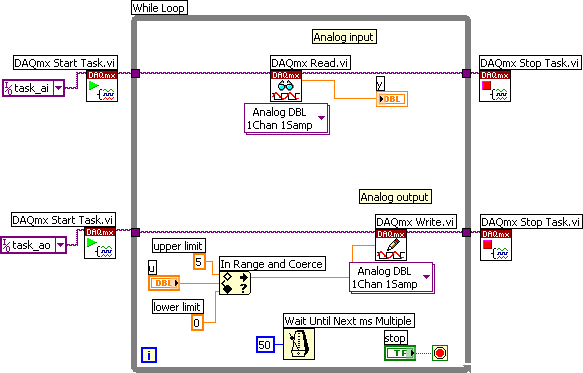


- NI USB-6008/6009 User Guide and Specifications 2 ni.com Figure 1. NI USB-6008/6009 Top View Figure 2. NI USB-6008/6009 Back View Table 2. Differences Between the NI USB-6008 and NI USB-6009 Feature NI USB-6008 NI USB-6009 AI Resolution 12 bits differential, 11 bits single-ended 14 bits differential, 13 bits single-ended Maximum AI Sample Rate.
- The National Instruments USB-6501 USB Digital I/O Device is a portable digital I/O device that provides reliable data acquisition and control. With plug-and-play USB connectivity, the USB-6501 is simple enough for home/academic applications but robust.
The NI USB-6501 is a digital IO module for USB from National Instruments. Unfortunately, their driver for Linux is excessively large ( 60M!) and didn't work. So we decided to analyze the USB protocol and write our own driver. The result can be found in the directory c/. For further details, have a look at doc/documentation.html.
Ni-usb 6501 Labview Driver

- NI USB-6008/6009 User Guide and Specifications 2 ni.com Figure 1. NI USB-6008/6009 Top View Figure 2. NI USB-6008/6009 Back View Table 2. Differences Between the NI USB-6008 and NI USB-6009 Feature NI USB-6008 NI USB-6009 AI Resolution 12 bits differential, 11 bits single-ended 14 bits differential, 13 bits single-ended Maximum AI Sample Rate.
- The National Instruments USB-6501 USB Digital I/O Device is a portable digital I/O device that provides reliable data acquisition and control. With plug-and-play USB connectivity, the USB-6501 is simple enough for home/academic applications but robust.
The NI USB-6501 is a digital IO module for USB from National Instruments. Unfortunately, their driver for Linux is excessively large ( 60M!) and didn't work. So we decided to analyze the USB protocol and write our own driver. The result can be found in the directory c/. For further details, have a look at doc/documentation.html.
Ni-usb 6501 Labview Driver
2006-01-17 00:10:54 UTC
Ni-usb 6501 Labview Drivers
I am attempting to port a hardware handshaking and digital I/O communication protocol (called TEMPO VideoSync) written in C from Mac OS9 (using an NI PCI-DIO-96 and NI-DAQ Version 6.1 for Mac) to Mac OSX (possibly using an NI USB-6501 and NI-DAQmx Base Version 2.0)
1. Am I correct that the drivers and C command library for the NI USB-6501 are contained in NI-DAQmx Base Version 2.0?
2. Does NI-DAQmx Base Version 2.0 have C commands equivalent to the following from NI-DAQ Version 6.1 for Mac used in the Mac OS9 version? Board_ID(slot, boardtype) DIG_Prt_Config(devicenumber, port, direction, mode) DIG_In_Port(devicenumber, port, pattern) DIG_Out_Port(devicenumber, port, pattern)
3. Related to the question above, will the NI USB-6501 be controlled by the C code in much the same way the PCI-DIO-96 was? (i.e., First the device is identified on the system, then cast the data direction of various ports and pins as either output or input, with or without handshaking, then different code sections of reading and writing on the pins per the communication protocol being used.)
4. As a USB device, should I be concerned about the speed at which the C code can control the NI USB-6501 as compared to the NI PCI-DIO-96?
5. I actually have an extra NI PCI-DIO-96 card, but am I correct that there is neither the driver software nor a way to use a PCI card in a OSX Mac G5 with only PCI Express slots?
Thank you very much for any advice on these matters.
Daniel ShimaVanderbilt Vision Research Center
1. Am I correct that the drivers and C command library for the NI USB-6501 are contained in NI-DAQmx Base Version 2.0?
2. Does NI-DAQmx Base Version 2.0 have C commands equivalent to the following from NI-DAQ Version 6.1 for Mac used in the Mac OS9 version? Board_ID(slot, boardtype) DIG_Prt_Config(devicenumber, port, direction, mode) DIG_In_Port(devicenumber, port, pattern) DIG_Out_Port(devicenumber, port, pattern)
3. Related to the question above, will the NI USB-6501 be controlled by the C code in much the same way the PCI-DIO-96 was? (i.e., First the device is identified on the system, then cast the data direction of various ports and pins as either output or input, with or without handshaking, then different code sections of reading and writing on the pins per the communication protocol being used.)
4. As a USB device, should I be concerned about the speed at which the C code can control the NI USB-6501 as compared to the NI PCI-DIO-96?
5. I actually have an extra NI PCI-DIO-96 card, but am I correct that there is neither the driver software nor a way to use a PCI card in a OSX Mac G5 with only PCI Express slots?
Thank you very much for any advice on these matters.
Daniel ShimaVanderbilt Vision Research Center

